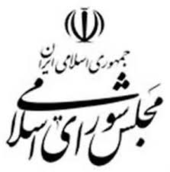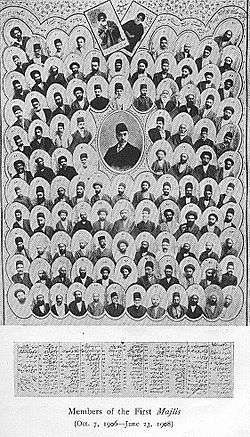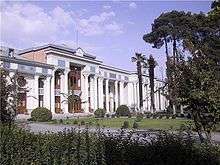Islamic Consultative Assembly
| Islamic Consultative Assembly مجلس شورای اسلامی Majles-e Showrā-ye Eslāmī | |
|---|---|
|
34th Majles 10th Islamic Consultative Assembly | |
 | |
| Type | |
| Type | |
| History | |
| Founded | March 14, 1980 |
| Preceded by | National Consultative Assembly |
New session started | 28 May 2016 |
| Leadership | |
First Deputy | |
Second Deputy | |
Wilayat fraction leader |
Hamid-Reza Haji Babaee Since 23 October 2016 |
Hope fraction leader |
Mohammad Reza Aref Since 20 July 2016 |
| Structure | |
| Seats | 290[1] |
 | |
Political groups |
|
Length of term | 4 years[1] |
| Elections | |
| Qualified majority two-round system[1] | |
Last election | 26 February and 29 April 2016 |
| Meeting place | |
.jpg) | |
|
Islamic Consultative Assembly Baharestan Tehran Iran | |
| Website | |
|
http://www.Majlis.ir http://parlemannews.ir/ http://www.icana.ir/ | |
| Constitution | |
| Constitution of Islamic Republic of Iran | |
The Islamic Consultative Assembly (Persian: مجلس شورای اسلامی Majles-e Showrā-ye Eslāmī), also called the Iranian Parliament, the Iranian Majlis (or Majles, مجلس), or the People's House (خانه ملت), is the national legislative body of Iran. The Parliament currently has 290 representatives, changed from the previous 272 seats since the 18 February 2000 election. The most recent election took place on 26 February 2016 and the new parliament was opened on 28 May 2016.[2]
History
Imperial State of Iran: National Consultative Assembly

Before the Islamic Revolution, Majlis was also the name of the lower house of the Iranian Legislature from 1906 to 1979, the upper house being the Senate.
It was created by the Iran Constitution of 1906 and first convened on 7 October 1906 (Iranian Calendar: 1285-Mehr-13),[3] soon gaining power under the rule of the Shah Mohammad Reza Pahlavi. Noteworthy bills passed by the Parliament under the Pahlavi Dynasty include the Oil Nationalization Bill (15 March 1951) and the Family Protection Law (1967), which gave women many basic rights such as custody of children in the case of divorce.
Women were not allowed to vote or be elected to the Parliament until 1963, as part of reforms under the Shah's "White Revolution". The twenty-first National Consultative Assembly, which included female representatives, opened on 6 October 1963.
The last session of the Pre-Revolution Parliament was held on 7 February 1979 (18 Bahman 1357 AP[3]).
Islamic Republic of Iran: Islamic Consultative Assembly
After the Iranian Revolution of 1979, the Senate of Iran was abolished and was effectively replaced by the Guardian Council thus the Iranian legislature remained bicameral. In the 1989 revision of the constitution, the National Consultative Assembly became the Islamic Consultative Assembly.
The Parliament of Iran has had six chairmen since the Iranian Revolution. Akbar Hashemi Rafsanjani was the first chairman, from 1980 to 1989. Then came Mehdi Karroubi (1989–1992), Ali Akbar Nategh-Nouri (1992–2000), Mehdi Karroubi (2000–2004), Gholam-Ali Haddad-Adel (2004–2008) and Ali Larijani since 2008.
Over its history the Parliament is said to have evolved from being "a debating chamber for notables," to "a club for the shah's placemen" during the Pahlavi era, to a body dominated by members of "the propertied middle class" under the Islamic Republic.[4][5]
2016 election
| This article is part of a series on the |
| Politics of the Islamic Republic of Iran |
|---|
 |
| Government of Islamic Republic of Iran |
|
Supreme Councils |
|
Local governments |
|
|
|
The last elections of Parliament of Iran were held on 26 March 2016 with a second round will be held in April in those 71 districts where no candidate received 25% or more of the votes cast. More than 12,000 candidates registered but leaving about 6,200 candidates to run for the 290 seats representing the 31 provinces. The results indicate that the results would make a hung parliament with reformists having a plurality.
Members
Currently, the Parliament's 290 members, fourteen of whom represent non-Muslim religious minorities(4.8%), are popularly elected for four-year terms. About 8% of the Parliament are women, while the global average is 13%.[6] The Parliament can force the dismissal of cabinet ministers by no-confidence votes and can impeach the president for misconduct in office. Although the executive proposes most new laws, individual deputies of the Parliament also may introduce legislation. Deputies also may propose amendments to bills being debated. The Parliament also drafts legislation, ratifies international treaties, and approves the national budget.
All People's House of Iran candidates and all legislation from the assembly must be approved by the Guardian Council. Candidates must pledge in writing that they are committed, in theory and in practice, to the Iranian constitution.
Leadership
Members of Parliament elect their speaker and deputy speakers during the first session of Parliament for a one-year term. Every year, almost always in May, elections for new speakers are held in which incumbents may be re-elected.
The current Speaker of Parliament is Ali Larijani, with First Deputy Speaker Masoud Pezeshkian and Second Deputy Speaker Ali Motahari.
Committees
|
|
Building
From 1979, the Parliament had convened at the building that used to house the Senate of Iran. A new building was built for the Assembly at Baharestan Square in central Tehran, near the old Iranian Parliament's building that was used from 1906 to 1979. After several debates, the move was finally approved in 2004. The first session of the Parliament was held on 16 November 2004 in the new building.
The old building is depicted on the reverse of the Iranian 100 rials banknote.[7]

.jpg)
 The third building
The third building
(used: 2004–present)
See also
References
- ↑ Mohammad-Ali Hosseinzadeh (deceased), Minoo Khaleghi (disualified), Beytollah Abdollahi and Khaled Zamzamnejad (votes voided).
- 1 2 3 4 Nohlen, Dieter; Grotz, Florian; Hartmann, Christof (2001). "Iran". Elections in Asia: A Data Handbook. I. Oxford University Press. p. 64. ISBN 0-19-924958-X.
- ↑ Large scale turn out at polls in IRI March Majlis Elections IRNA
- 1 2 Mohammad Modarresi (2005). "An Introduction to the history of the Legislative Assembly In Iran: The First Parliament of the National Consultative Assembly (آشنایی با تاریخ مجالس قانونگذاری در ایران: دوره اول مجلس شورای ملی)" (PDF) (in Persian). The Research Center of Islamic Consultative Assembly (مرکز پژوهشهای مجلس شورای اسلامی).
- ↑ Abrahamian, History of Modern Iran, (2008), p. 179
- ↑ Islamic Majles, Ashnai-ye Ba Majles-e Showra-ye Islami, Vol.ii (Guide to the Islamic Majles, Tehran, 1992, p. 205
- ↑ On Women’s Day, struggle for equality remains, Kyiv Post (8 March 2012)
- ↑ Central Bank of Iran. Banknotes & Coins: 100 Rials. – Retrieved on 24 March 2009.
External links
| Wikimedia Commons has media related to Majlis. |
- The official website of the Majlis of Iran
- Laws and minutes of meetings of the Majlis of Iran (1906-1979) (persian)
- History of Iran: Constitutional Revolution, a history of Majlis from 1906 to 1953
- Iranian Ministry of Interior on the history of elections in Iran
- A report on moving the Majles to Baharestan
- The Council of Guardians, Official website.
- The Majles, Iran's parliament news service.
- Interparliamentary Union (IPU) summary of Majlis of Iran election preparations and/or outcomes (translated into English)
- Iran Electoral Archive - Iranian Parliament
- Videos
- Iran’s ninth parliament PressTV (2012)
- Parliamentary election in Iran (I) (II) (III) (IV) (V) (VI) (VII) Second Round PressTV (2012)
- Video Archive of Iran's Parliament
- Kourosh Esmāili, People & Power: The Iranian Campaign, Aljazeera, YouTube, April 2008: Part 1 Part 2
Coordinates: 35°41′30.28″N 51°26′04″E / 35.6917444°N 51.43444°E
